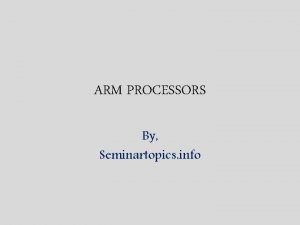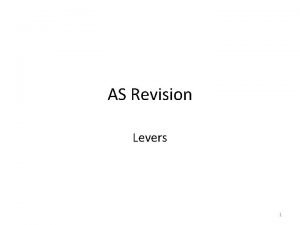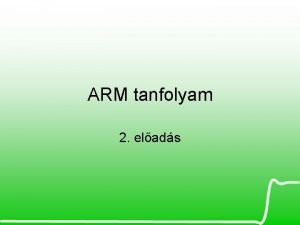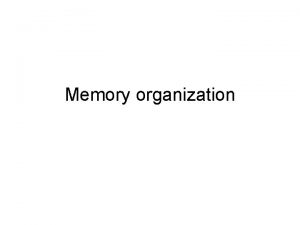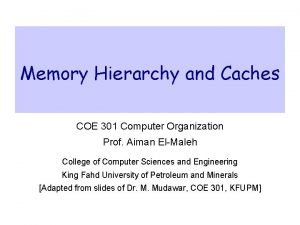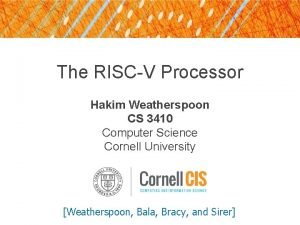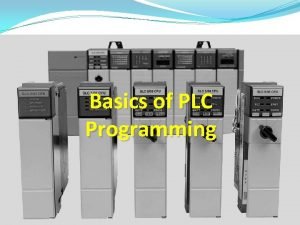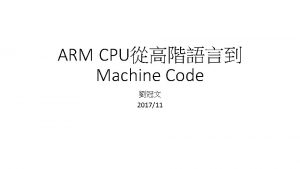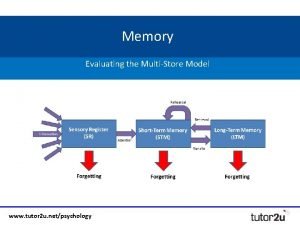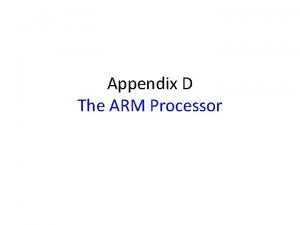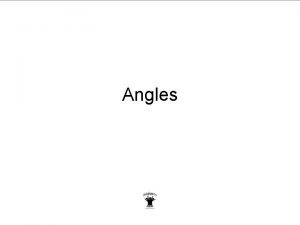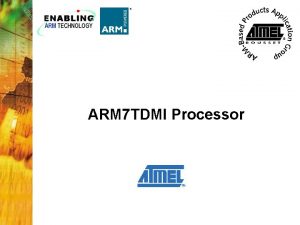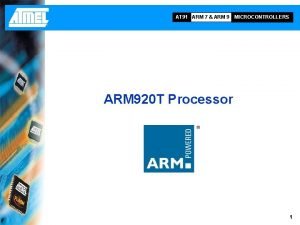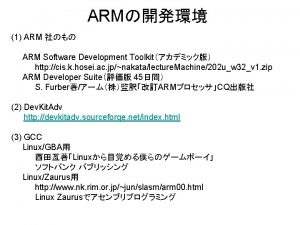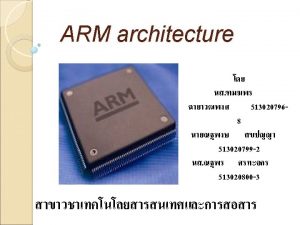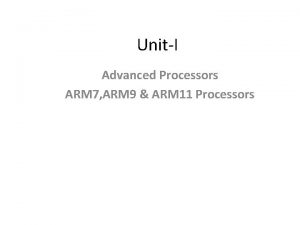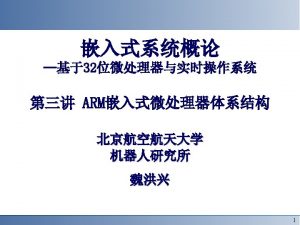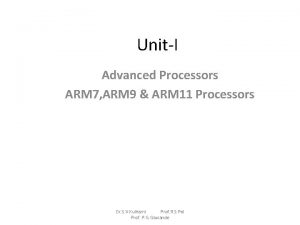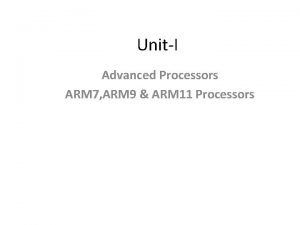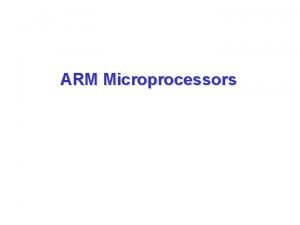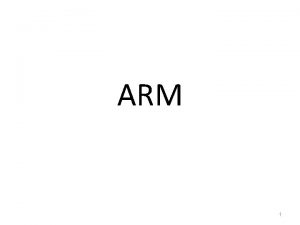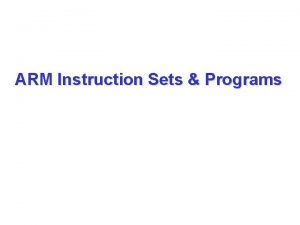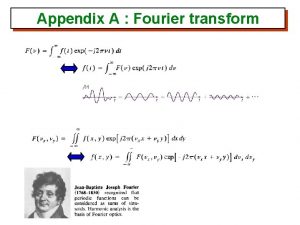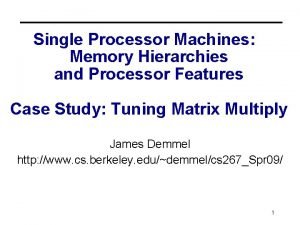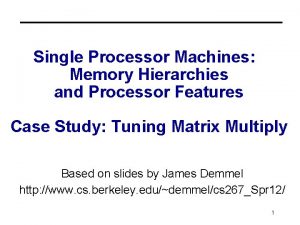Appendix D The ARM Processor Appendix Outline Memory












![Addressing modes • Pre-indexed mode: LDR Rd, [Rn, #offset] performs Rd ← [[Rn] + Addressing modes • Pre-indexed mode: LDR Rd, [Rn, #offset] performs Rd ← [[Rn] +](https://slidetodoc.com/presentation_image_h/204cc93370ef85f9b28983a993d49ce1/image-13.jpg)
![Addressing modes • Relative mode: LDR Rd, ITEM performs Rd ← [[PC] + offset] Addressing modes • Relative mode: LDR Rd, ITEM performs Rd ← [[PC] + offset]](https://slidetodoc.com/presentation_image_h/204cc93370ef85f9b28983a993d49ce1/image-14.jpg)

![Addressing modes • Post-indexed mode (a generalization of the autoincrement mode): LDR Rd, [Rn], Addressing modes • Post-indexed mode (a generalization of the autoincrement mode): LDR Rd, [Rn],](https://slidetodoc.com/presentation_image_h/204cc93370ef85f9b28983a993d49ce1/image-16.jpg)











![Instructions • Arithmetic: MUL R 0, R 1, R 2 performs R 0←[R 1] Instructions • Arithmetic: MUL R 0, R 1, R 2 performs R 0←[R 1]](https://slidetodoc.com/presentation_image_h/204cc93370ef85f9b28983a993d49ce1/image-28.jpg)

![Instructions • Move: MOV Rd, Rm performs Rd ← [Rm] MOV Rd, #value performs Instructions • Move: MOV Rd, Rm performs Rd ← [Rm] MOV Rd, #value performs](https://slidetodoc.com/presentation_image_h/204cc93370ef85f9b28983a993d49ce1/image-30.jpg)
![Instructions • Move: MVN Rd, Rm or #value loads the bit-complement of [Rm] or Instructions • Move: MVN Rd, Rm or #value loads the bit-complement of [Rm] or](https://slidetodoc.com/presentation_image_h/204cc93370ef85f9b28983a993d49ce1/image-31.jpg)





![Instructions • Compare: CMP Rn, Rm performs [Rn] - [Rm] and updates condition code Instructions • Compare: CMP Rn, Rm performs [Rn] - [Rm] and updates condition code](https://slidetodoc.com/presentation_image_h/204cc93370ef85f9b28983a993d49ce1/image-37.jpg)
















- Slides: 53

Appendix D The ARM Processor

Appendix Outline • • • Memory organization Characteristics of the ARM ISA Register structure and addressing modes Instructions and assembly language Operating modes and exceptions Input/output

Memory organization Byte-addressable, 32 -bit address space Little- or big-endian addressable 32 -bit word length Word, half-word, and byte data transfers to and from processor registers • Word and half-word transfers must be aligned • •

Instruction set characteristics • RISC-style aspects: All instructions 32 bits long Only Load and Store instructions access memory Arithmetic and logic instructions operate on processor register contents

Instruction set characteristics • CISC-style aspects: Autoincrement, autodecrement, and PC-relative addressing modes provided Condition codes used for conditional execution of instructions Multiple word Loads and Stores implemented with single instructions

Unusual aspects of the ISA • Conditional execution of instructions: All instructions, including branches, are executed conditionally, based on a 4 -bit condition field value in each instruction • No explicit shift instructions; but one operand of an operation can be preshifted • Many multiply instructions, but no divide instructions

Register structure • Sixteen 32 -bit processor registers, labeled R 0 through R 15 • Register R 15 is the program counter (PC) • Registers R 13 and R 14 have dedicated uses related to subroutine and processor stack management • A status register (CPSR) holds the condition code flags (N, Z, C, V), two interruptdisable bits, and five processor mode bits


Banked registers • Duplicates of some of the registers in the range R 8 through R 14 are provided for each of the processor modes other than the User and System modes • Banked registers make context switches between the modes more efficient by avoiding register save/restore operations on such switches

Addressing modes • All modes are derived from a basic form of indexed addressing • The effective address of a memory operand is the sum of the contents of a base register Rn and a signed offset • The offset is either a 12 -bit immediate value in the instruction or the contents of a second register Rm

Addressing modes • Examples of addressing modes can be shown by using the Load instruction LDR, whose format is given in following slide • The store instruction STR has same format • Both LDR and STR access a word location

![Addressing modes Preindexed mode LDR Rd Rn offset performs Rd Rn Addressing modes • Pre-indexed mode: LDR Rd, [Rn, #offset] performs Rd ← [[Rn] +](https://slidetodoc.com/presentation_image_h/204cc93370ef85f9b28983a993d49ce1/image-13.jpg)
Addressing modes • Pre-indexed mode: LDR Rd, [Rn, #offset] performs Rd ← [[Rn] + offset] LDR Rd, [Rn, Rm] performs Rd ← [[Rn] + [Rm]]
![Addressing modes Relative mode LDR Rd ITEM performs Rd PC offset Addressing modes • Relative mode: LDR Rd, ITEM performs Rd ← [[PC] + offset]](https://slidetodoc.com/presentation_image_h/204cc93370ef85f9b28983a993d49ce1/image-14.jpg)
Addressing modes • Relative mode: LDR Rd, ITEM performs Rd ← [[PC] + offset] where offset is calculated by the assembler

Addressing modes • Pre-indexed with writeback (a generalization of the autodecrement mode): LDR Rd, [Rn, #offset]! performs Rd ← [[Rn] + offset] followed by Rn ← [Rn] + offset (Rm can be used instead of #offset)
![Addressing modes Postindexed mode a generalization of the autoincrement mode LDR Rd Rn Addressing modes • Post-indexed mode (a generalization of the autoincrement mode): LDR Rd, [Rn],](https://slidetodoc.com/presentation_image_h/204cc93370ef85f9b28983a993d49ce1/image-16.jpg)
Addressing modes • Post-indexed mode (a generalization of the autoincrement mode): LDR Rd, [Rn], #offset performs Rd ← [[Rn]] followed by Rn ← [Rn] + offset (Rm can be used instead of #offset)

Addressing modes • If the offset is given as the contents of Rm, it can be shifted before being used Example: LDR R 0, [R 1, -R 2, LSL #4]! performs R 0 ← [[R 1] - 16 [R 2]] followed by R 1 ← [R 1] - 16 [R 2]






Instructions • Load and Store: LDR and STR for words LDRH and STRH for half words (zero-extended on a Load) LDRB and STRB for bytes (zero-extended on a Load) LDRSH and LDRSB are used for sign-extended Loads (Half words and bytes are positioned at the low-order end of a register)

Instructions • Multiple-word Load and Store: Any subset of the processor registers can be loaded or stored with the Block Transfer instructions LDM and STM Example: LDMIA R 10!, [R 0, R 1, R 6, R 7] If [R 10] = 1000, words at 1000, 1004, 1008, and 1012 are loaded into the registers, and R 10 contains 1016 after all transfers

Instructions • Arithmetic: Assembly language format is OP Rd, Rn, Rm or #offset ADD R 0, R 2, R 4 performs R 0 ← [R 2] [R 4] SUB R 0, R 3, #17 performs R 0 ← [R 3] 17 (immediates are unsigned values in the range 0 to 255)

Instructions • Arithmetic: The second source operand can be shifted or rotated before being used ADD R 0, R 1, R 5, LSL #4 performs R 0 ← [R 1] + 16 × [R 5] Shifts and rotations available: LSL Logical shift left LSR Logical shift right ASR Arithmetic shift right ROR Rotate right

Instructions • Shifting/rotation of the second source operand in arithmetic instructions: The last bit shifted (or rotated) out is written into the C flag A second rotation operation, labeled RRX (Rotate right extended), includes the C flag in the bits being rotated; only rotates by 1 bit (If the second source operand is an immediate value, a limited form of rotation is provided)
![Instructions Arithmetic MUL R 0 R 1 R 2 performs R 0R 1 Instructions • Arithmetic: MUL R 0, R 1, R 2 performs R 0←[R 1]](https://slidetodoc.com/presentation_image_h/204cc93370ef85f9b28983a993d49ce1/image-28.jpg)
Instructions • Arithmetic: MUL R 0, R 1, R 2 performs R 0←[R 1] × [R 2] The low-order 32 bits of the 64 -bit product are written into R 0 For 2’s-complement numbers, the value in R 0 is correct if the product fits into 32 bits

Instructions • Arithmetic: MLA R 0, R 4, R 5, R 6 performs R 0 ← ([R 4] × [R 5]) + [R 6] This Multiply-Accumulate instruction is useful in signal-processing applications Other versions of MUL and MLA generate 64 -bit products
![Instructions Move MOV Rd Rm performs Rd Rm MOV Rd value performs Instructions • Move: MOV Rd, Rm performs Rd ← [Rm] MOV Rd, #value performs](https://slidetodoc.com/presentation_image_h/204cc93370ef85f9b28983a993d49ce1/image-30.jpg)
Instructions • Move: MOV Rd, Rm performs Rd ← [Rm] MOV Rd, #value performs Rd ← value (The second operand can be shifted/rotated)
![Instructions Move MVN Rd Rm or value loads the bitcomplement of Rm or Instructions • Move: MVN Rd, Rm or #value loads the bit-complement of [Rm] or](https://slidetodoc.com/presentation_image_h/204cc93370ef85f9b28983a993d49ce1/image-31.jpg)
Instructions • Move: MVN Rd, Rm or #value loads the bit-complement of [Rm] or value into Rd

Instructions • Implementing Shift and Rotate instructions: MOV Ri, Rj, LSL #4 achieves the same result as the generic instruction: LShift. L Ri, Rj, #4

Instructions • Logic: AND Rd, Rn, Rm performs the bit-wise logical AND of the operands in registers Rn and Rm and writes the result into register Rd ORR (bit-wise logical OR) EOR (bit-wise logical XOR) are also provided

Instructions • Logic: The Bit Clear instruction, BIC, is closely related to the AND instruction The bits of Rm are complemented before they are ANDed with the bits of Rn If R 0 contains the hexadecimal pattern 02 FA 62 CA, and R 1 contains 0000 FFFF, BIC R 0, R 1 results in 02 FA 0000 being written into R 0

Instructions • Test: TST Rn, Rm or #value performs bit-wise logical AND of the two operands, then sets condition code flags TST R 3, #1 sets Z ← 1 if low-order bit of R 3 is 0 sets Z ← 0 if low-order bit of R 3 is 1 (useful for checking status bits in I/O devices)

Instructions • Test: TEQ Rn, Rm or #value performs bit-wise logical XOR of the two operands, then sets condition code flags TEQ R 2, #5 sets Z ← 1 if R 2 contains 5 sets Z ← 0 otherwise
![Instructions Compare CMP Rn Rm performs Rn Rm and updates condition code Instructions • Compare: CMP Rn, Rm performs [Rn] - [Rm] and updates condition code](https://slidetodoc.com/presentation_image_h/204cc93370ef85f9b28983a993d49ce1/image-37.jpg)
Instructions • Compare: CMP Rn, Rm performs [Rn] - [Rm] and updates condition code flags based on the result

Instructions • Setting condition code flags CMP, TST, and TEQ, always update the condition code flags Arithmetic, Logic, and Move instructions do so only if S is appended to the OP code ADDS updates flags, but ADD does not

Instructions • Adding 64 -bit operands ADC performs R 0, R 1, R 2 (Add with carry) R 0 ← [R 1] + [R 2] + [C] If pairs R 3, R 2 and R 5, R 4 hold 64 -bit operands, ADDS R 6, R 2, R 4 ADC R 7, R 3, R 5 writes their sum into register pair R 7, R 6

Instructions • Branch: B{condition} LOCATION branches to LOCATION if the settings of the condition code flags satisfy {condition} BEQ LOCATION branches if Z = 1



Program • An assembly-language program for adding numbers stored in the memory is shown in the next slide The instruction LDR R 2, =NUM 1 is a pseudoinstruction that loads the 32 -bit address value NUM 1 into R 2 It is implemented using actual instructions


Instructions • Subroutine linkage: BL SUBADDRESS Actions taken: 1. The value of the updated PC is stored in R 14 (LR), the Link register 2. A branch is taken to SUBADDRESS


Assembly language • An assembly language program for adding numbers is given in the next slide • Comments: 1. The AREA directive specifies the start of instruction (CODE) and data (DATA) areas 2. The ENTRY directive specifies the start point for program execution


Assembly language • Comments (continued) 3. The combination of the instruction LDR R 2, POINTER and the data declaration POINTER DCD NUM 1 implements the pseudoinstruction LDR R 2, =NUM 1

Pseudoinstructions • Operations specified by pseudoinstructions are implemented with actual machine instructions by the assembler • Example: An immediate is an 8 -bit unsigned value The pseudoinstruction MOV R 0, #-5 is implemented with the actual instruction MVN R 0, #4 (the bit-complement of 4 = 00000100 -5 = 11111011)

Pseudoinstructions • Loading 32 -bit values: The pseudoinstruction LDR Rd, =value loads a 32 -bit value into Rd LDR R 3, =127 is implemented with MOV R 3, #127 (used for “short” values)

Pseudoinstructions • Loading 32 -bit values: LDR R 3, =&A 123 B 456 is implemented with LDR R 3, MEMLOC (instruction) MEMLOC DCD &A 123 B 456 (data) (used for “long” values, including addresses)

Pseudoinstructions • Loading 32 -bit address label values: If the address is “close” to the current value of the program counter (R 15), the ADR pseudoinstruction can be used ADR Rd, LOCATION is implemented with ADD Rd, R 15, #offset, or SUB Rd, R 15, #offset (offset is calculated by the assembler)
 Arm architecture history
Arm architecture history Advantages and disadvantages of first class levers
Advantages and disadvantages of first class levers Everyday examples of levers
Everyday examples of levers Linker arm left arm
Linker arm left arm Infrabulge clasp
Infrabulge clasp Direct retainers
Direct retainers Effort arm and resistance arm
Effort arm and resistance arm Give the structure of commercial 8mx 8 bit dram chip
Give the structure of commercial 8mx 8 bit dram chip Processor memory gap
Processor memory gap How 0x86 processor stores ox12345678 in memory?
How 0x86 processor stores ox12345678 in memory? Processor memory organization in plc
Processor memory organization in plc Outline arm
Outline arm Primary memory and secondary memory
Primary memory and secondary memory Virtual memory in memory hierarchy consists of
Virtual memory in memory hierarchy consists of Semantic knowledge
Semantic knowledge Logical address
Logical address Eidetic memory vs iconic memory
Eidetic memory vs iconic memory Explicit memory
Explicit memory Which memory is the actual working memory?
Which memory is the actual working memory? Shared vs distributed memory
Shared vs distributed memory Internal memory and external memory
Internal memory and external memory Long term memory vs short term memory
Long term memory vs short term memory Page fault
Page fault Multi store model evaluation
Multi store model evaluation Quote one topic sentence
Quote one topic sentence Các châu lục và đại dương trên thế giới
Các châu lục và đại dương trên thế giới Thế nào là hệ số cao nhất
Thế nào là hệ số cao nhất Sơ đồ cơ thể người
Sơ đồ cơ thể người Tư thế ngồi viết
Tư thế ngồi viết đặc điểm cơ thể của người tối cổ
đặc điểm cơ thể của người tối cổ Cái miệng bé xinh thế chỉ nói điều hay thôi
Cái miệng bé xinh thế chỉ nói điều hay thôi Cách giải mật thư tọa độ
Cách giải mật thư tọa độ Bổ thể
Bổ thể Glasgow thang điểm
Glasgow thang điểm ưu thế lai là gì
ưu thế lai là gì Tư thế ngồi viết
Tư thế ngồi viết Thẻ vin
Thẻ vin Thơ thất ngôn tứ tuyệt đường luật
Thơ thất ngôn tứ tuyệt đường luật Các châu lục và đại dương trên thế giới
Các châu lục và đại dương trên thế giới Từ ngữ thể hiện lòng nhân hậu
Từ ngữ thể hiện lòng nhân hậu Diễn thế sinh thái là
Diễn thế sinh thái là V cc
V cc 101012 bằng
101012 bằng Tỉ lệ cơ thể trẻ em
Tỉ lệ cơ thể trẻ em Hát lên người ơi
Hát lên người ơi Khi nào hổ con có thể sống độc lập
Khi nào hổ con có thể sống độc lập Lời thề hippocrates
Lời thề hippocrates đại từ thay thế
đại từ thay thế Quá trình desamine hóa có thể tạo ra
Quá trình desamine hóa có thể tạo ra Vẽ hình chiếu vuông góc của vật thể sau
Vẽ hình chiếu vuông góc của vật thể sau Công thức tiính động năng
Công thức tiính động năng Hát kết hợp bộ gõ cơ thể
Hát kết hợp bộ gõ cơ thể Thế nào là mạng điện lắp đặt kiểu nổi
Thế nào là mạng điện lắp đặt kiểu nổi Các loại đột biến cấu trúc nhiễm sắc thể
Các loại đột biến cấu trúc nhiễm sắc thể
